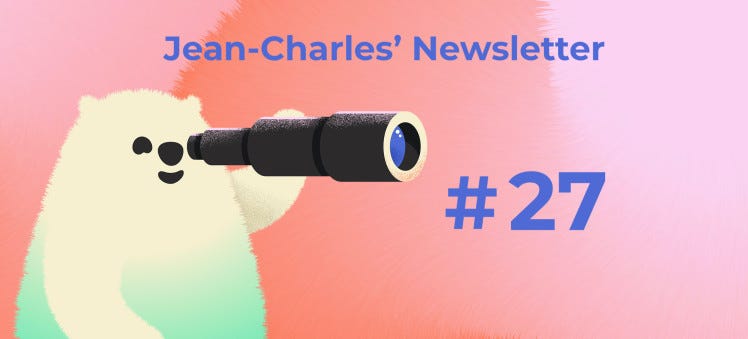Chaque semaine, je partage quelques articles que j’ai trouvés particulièrement enrichissants. J’espère qu’ils vous aideront autant qu’ils m’ont aidé.
Cette semaine:
Le cours des actions de Lemonade double après son introduction en bourse
Le risque des “gate keepers” qui veulent toujours modifier (Boz)
Comment ManoMano sélectionne ses produits
Comment commencer à Shape Up (basecamp)
Certains articles sont en français, la plupart sont en anglais (je copie certaines citations en anglais). Ils ne sont pas tous récents et vont au rythme de mes lectures.
Bonne lecture !
Si vous aimez, vous pouvez vous inscrire, partager ou encore me suivre sur Twitter.
📱Monde des technologies
👉 L’analyse de Lemonade et quand l’assurance se présente comme du SaaS (Hardware Club)
Lemonade is using a variety of re-insurance strategies to reduce as much as possible the volatility of its contribution margin per customer, inherent in the insurance businesse, in an attempt to look as much as possible like a SaaS business.
At the end of 2019, they have 643,118 customers on a Premium per Customer of $177.
👉 Le cours des actions Lemonade double après son introduction en bourse (The Financial Times)
The shares were priced at $29 each in the IPO (2020-07-02), but by lunchtime in New York they had reached more than $60. That placed the market capitalisation well beyond the $2bn reached in a funding round with SoftBank last year.
Less than a week later, shares are priced at more than $80 each, for a market cap of +$3.5bn.
🏯Construire une entreprise
👉 Return of the Mac (2005) (Paul Graham)
If you want to know what ordinary people will be doing with computers in ten years, just walk around the CS department at a good university. Whatever they’re doing, you’ll be doing.
In the matter of “platforms” this tendency is even more pronounced, because novel software originates with great hackers, and they tend to write it first for whatever computer they personally use. And software sells hardware. Many if not most of the initial sales of the Apple II came from people who bought one to run VisiCalc. And why did Bricklin and Frankston write VisiCalc for the Apple II? Because they personally liked it. They could have chosen any machine to make into a star.
If you want to attract hackers to write software that will sell your hardware, you have to make it something that they themselves use. It’s not enough to make it “open.” It has to be open and good. And open and good is what Macs are again, finally.
👉 Comment commencer à Shape Up (BaseCamp)
Dedicate one team and six weeks to explore a few tent-pole features and work out how they tie together into the main architecture of the product. The team should combine shaping and building in a blurry mix.
You don’t want separate shapers and builders at this stage because there are too many unknowns and the feedback loop will be too long and too slow.
There will come a time where it’s reasonable to flip from R&D to “production” mode.
👉 Value Add Disease : le risque des “gate keepers” qui veulent toujours modifier (Boz)
Gatekeepers can be a huge source of risk to doing great work.
People in positions of authority feel a sense of responsibility. Like anyone else they have a job to do and they want to do it well. If work is presented to them and they make no changes they may fear they have shirked their responsibility.
Don’t accept changes you don’t believe in without returning to the first principles that led to the decision in the first place.
Whenever possible frame meetings in terms of getting advice rather than asking permission.
Get comfortable with adding no value to the work you are responsible for. Consider instead that building teams that create good work without your help is precisely the kind of value you should be adding.
👉 Comment ManoMano sélectionne ce qu’ils construisent ou achètent (ManoMano)
Developing an in-house solution can still make sense: only a few range of any third-party tool features are generally used (let’s say 20%, it can even be less).
When MM’s needs are the same as everyone else in the industry, there is no value in redeveloping the solution since it won’t bring extra value.
A counterexample for us can be the CMS (Content Management System) that we chose to develop internally (even if we resorted to low level existing bricks like WYSIWYG editors, roles and administration management).
The ability to manage programmatically the tool (via an API) is thus critical.
Knowing that most of the solutions are billed on a per volume basis, it can become extremely expensive at some point. This is usually one of the reasons a company will re-internalize a third-party tool.
Final users should be at the heart of the RFP, supported by experts (architects, product managers, project manager, developers…).
Try as much as possible to test the solution through a POC. Sales rep from the editor often lie (unconsciously) because they are very far from the tech teams, so you have to test the tool in real conditions.
🏥 Santé
👉 Big Health lève 39 M€ pour continuer à développer ses apps de gestion du sommeil et de l’anxiété (Mobile Health).
💚 Les publications d’Alan et sur Alan
👉 Retour sur les derniers mois chez Alan (Blog Alan) : En ce début du mois de juillet, retour sur nos derniers développements, sur nos plans d'action pendant le coronavirus, et quelques explications sur notre décision de réviser les tarifs de nos produits Green et Blue.
👉 Podcast Generation Do It Yourself : Comment retourne-t-on un secteur a priori intouchable? Quelle a été l’idée de départ pour Alan ? Comment lever 12 millions avec seulement un google sheet ?
👉 ”De nos jours, on digitalise la santé !” : Alan était l’invité du podcast Planète Amabilis dans lequel on parle de digitalisation, de santé et de notre vision.




